Salvador Dali paintings & surrealism
Art is not created in vacuum. It forms as a product of cultural, economic and emotional baggage of the artist. Salvador Dali’ inner world is vast and complex, and his surreal symbols are hints to unpacking his creative mind and soul. Every artist starts his journey in the beginning.
The Dali museum in St. Petersburg divides its art collection into several sections – his early paintings of anti-art, surrealism, nuclear mysticism, and op art pieces. Housed in a sunlit, modern building, the show introduces us to Salvador Dali’ mind with his early paintings he completes at the 13 years of age. Early Dali art may shatter your perception of someone’s talent. It doesn’t look great. Dali early paintings show different styles and influences, mainly borrowing from the French impressionism and Fauvism movements. This is useful for artists to understand because we all create silly and unskillful art in the beginning.
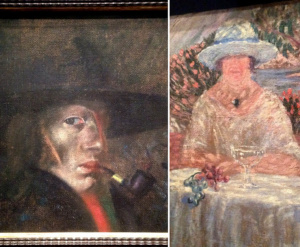
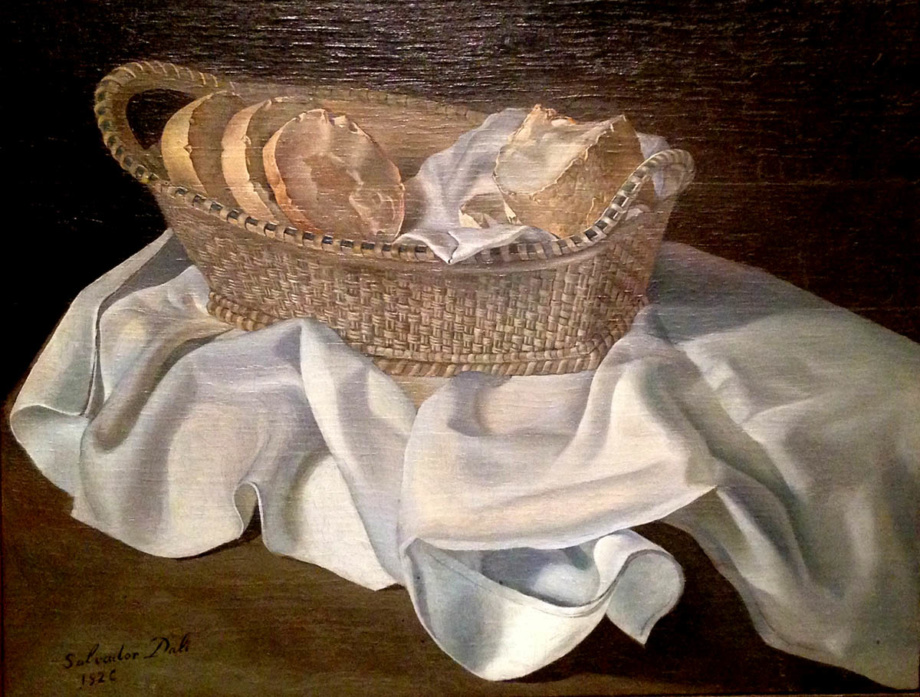
Salvador Dali art style evolution: from surrealism to symbolism to op art
Salvador Dali (1904-1989) is the most famous surrealist artist. His surreal paintings were my major influence in the past. I was fascinated with his skillful ability to express his psyche visually, painting the melting life inside him that went far beyond his dream state. With a remarkable skill, he renders tiny details on small panels and huge canvases alike. In his surreal art, Dali elongates the natural forms and de-personifies people with sightless, stretched or egg-like faces. He scatters the symbols throughout his paintings of complex stories and turns the rational world upside down in his vivid, barren landscapes.
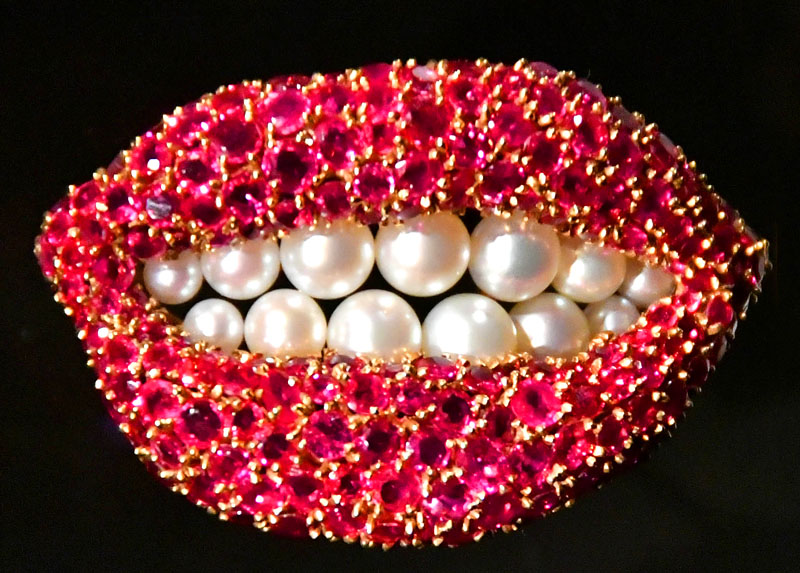
Why Dali left the surrealism movement
Deeply influenced by Sigmund Freud’s work “The Interpretation of Dreams,” Spanish artist explores the irrational and his dreams in the beginning of his career. Horrified by the rootlessness of the World War I, the surrealists rejected the rational mind and explored the irrational one instead. Although Dali is the most famous surrealist artist in the group, not many of us know that he broke away from the surrealist movement due to irreconcilable differences steeped in social and political views. The museum in St.Pete explains that Dali didn’t like the surrealists’ ideas of commune living and sharing, and his desire for self-promotion and individuality led him to part with the movement in a decade after he first joined the group in 1929. The artist gets fascinated with the optical illusions in art, creating his double image paintings still challenging our perception of the rational and irrational.
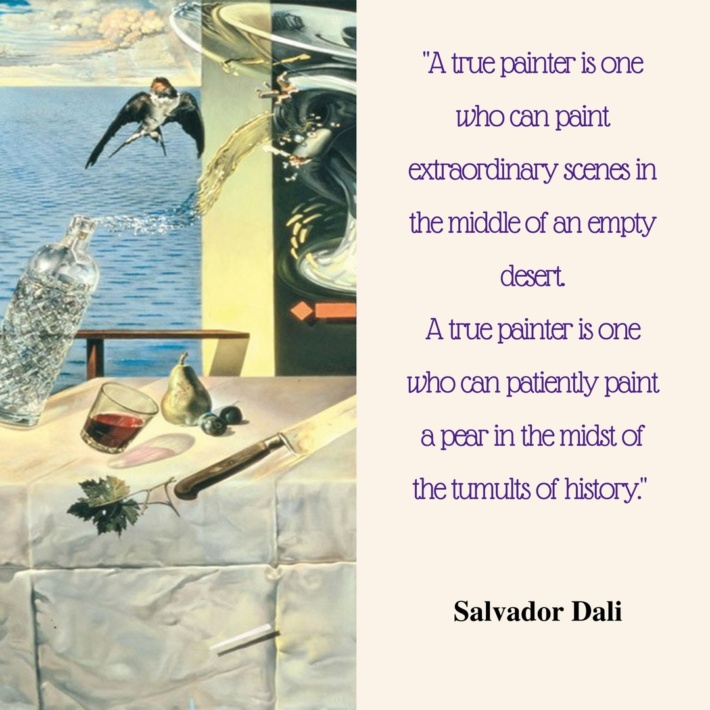
Dali Nuclear Mysticism & Op Art
Dali becomes a notorious artist who redefines himself and his mission after leaving the surrealists and entering the times of abstraction and subjectivity. He brands himself as a classical artist who loves Renaissance and aims to infuse his art with spirituality and classical ideals, unlike the abstract painters of his generation. He comes up with a new term the “nuclear mysticism,” and begins to paint huge canvases filled with the universal subjects, religious and historical themes. Influenced by the advances in science and technology, Salvador Dali’s late works (1949-1989) transform the surrealism style into monumental optical illusions, historical symbolism and the reverence for the universal. Besides having a number of solo shows in Spain and America, in 1974 he opens up his own museum in Figueres, Spain to house his art.
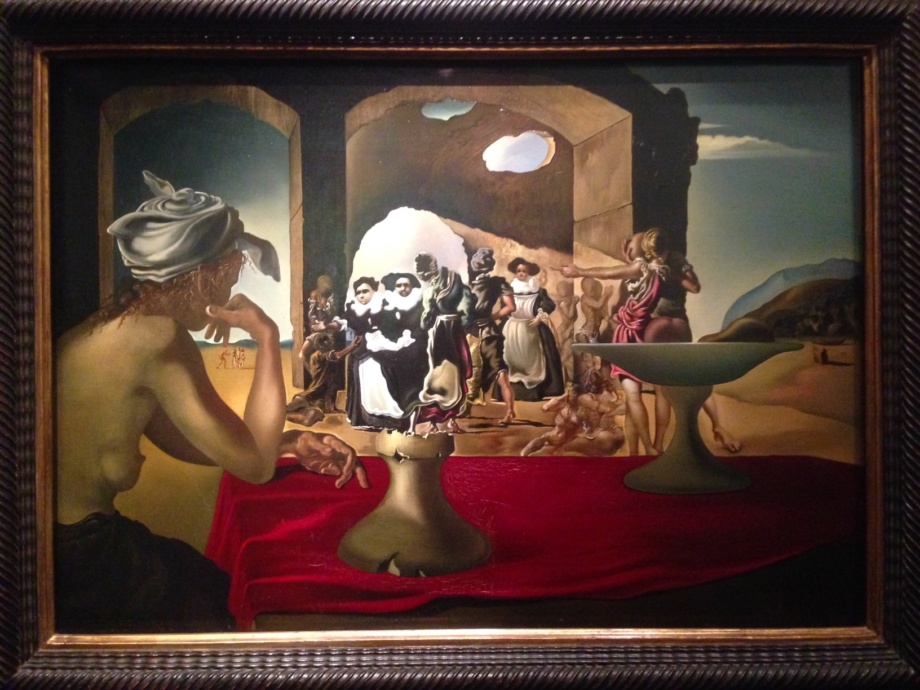
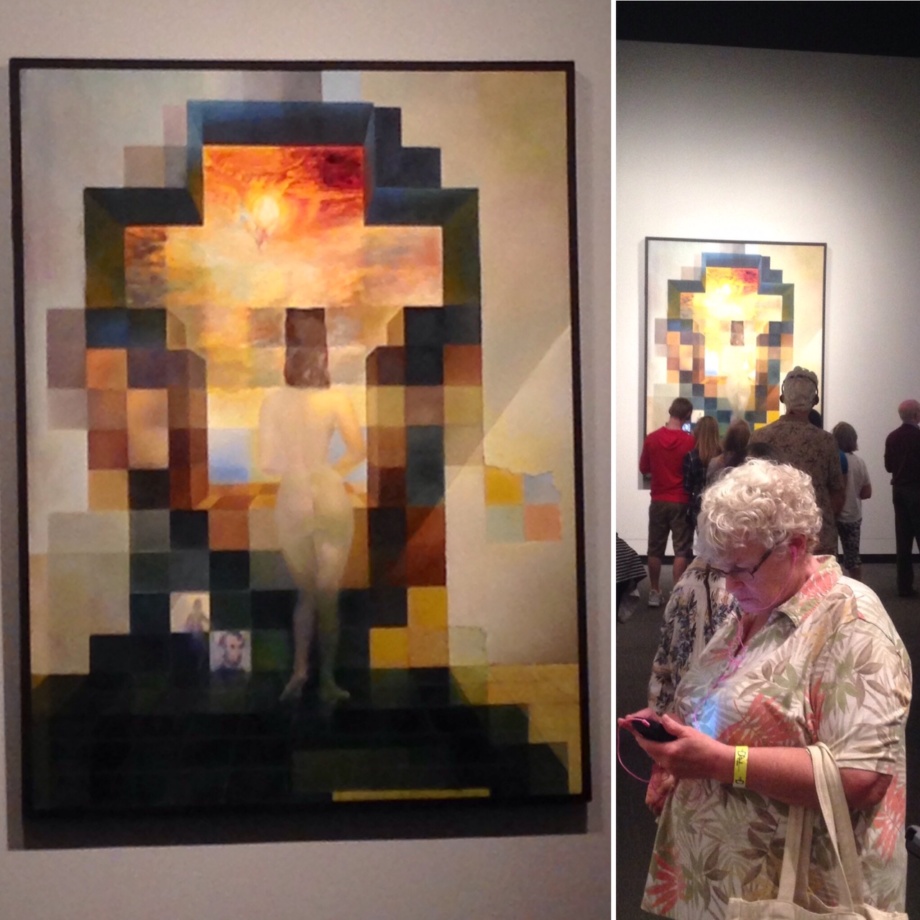
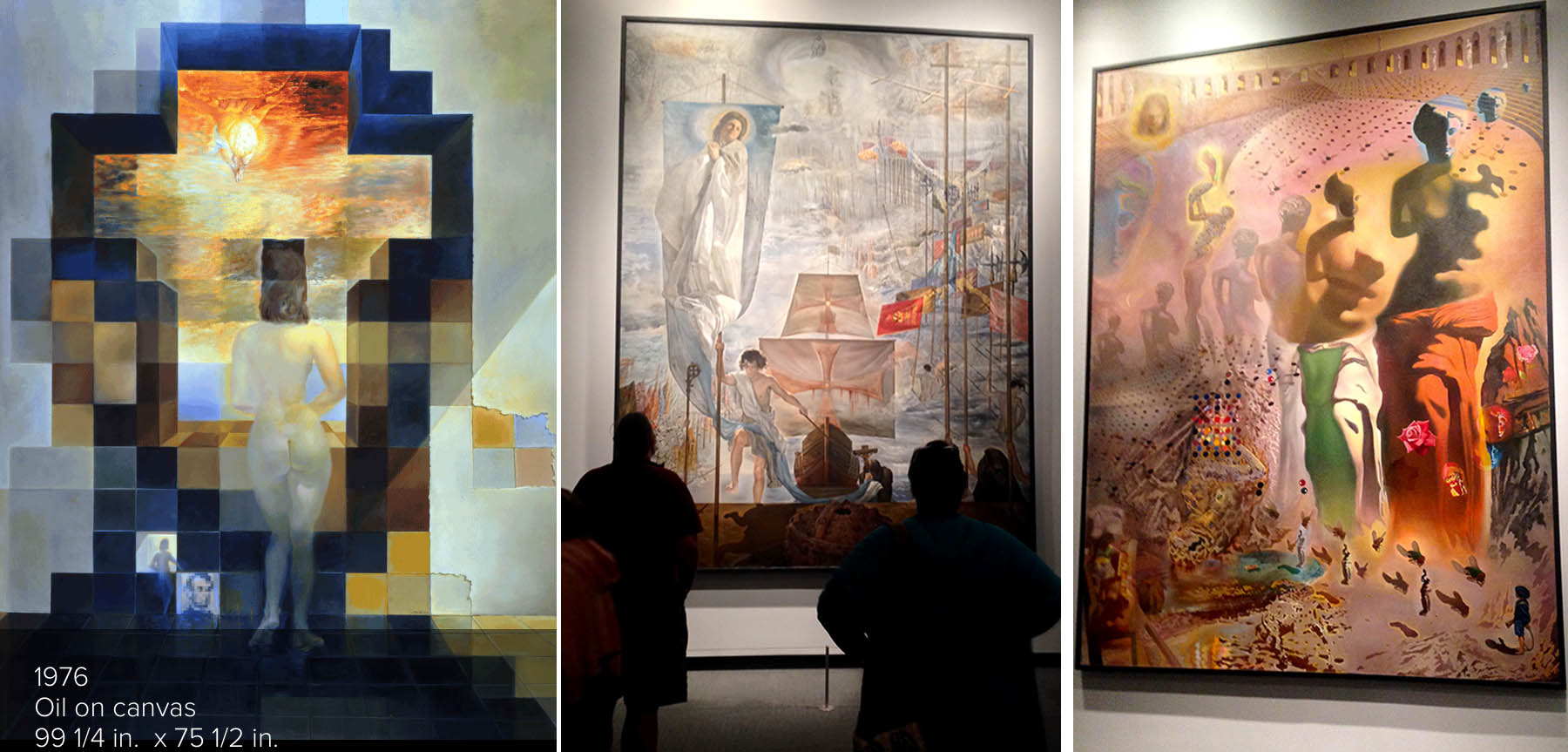
#1 the double image painting shows “Gala contemplating the Mediterranean sea which at twenty meters becomes the portrait of Abraham Lincoln.” Gala is a symbol of perfection and the Lincoln’s head with the crucifix give references to death and the fleeting nature of beauty.
#2 “The discovery of America by Christopher Columbus” shows the vast discoveries of humanity as well as Dali as an explorer. He paints Columbus as a young man stepping out to a new world.
#3 “The Hallucinogenic Toreador” depicts Venus 33 times. The goddess of love and beauty, the second figure hides a Toreador face within her body. The toreador represents masculinity, a boy represents and artist, and a dying bull shows death. The bust of Voltaire symbolizes reason, and at the top left we see Gala’s face again. This painting represents Desire and Death.
Dali symbolism in surrealism as an expression of his fears
Fear of women
Art is not created in a vacuum. It arises as an emotional product of cultural, economic and psychic world of the artist. Dali’s inner mind and heart is vast and complex, and his symbols become the hints to discovering and understanding the artist’s soul. Through his art, Salvador Dali reveals many of his fears. He often paints his sexual fear of women. Numerous surrealist paintings project the artist’s sexual anxieties in his self-portraits with soft, stretched heads and figures. He depicts women deformed, stretched or as the cut-outs during the surrealist period. He depicts his nanny as an old figure with a cut out body supported by the crutches. Women often turn their faces away from the viewer to conceal the artist’s emotions and insecurity towards the sex. It’s interesting to note that in his late works women become Venuses, saints and symbols of the female beauty for the artist.
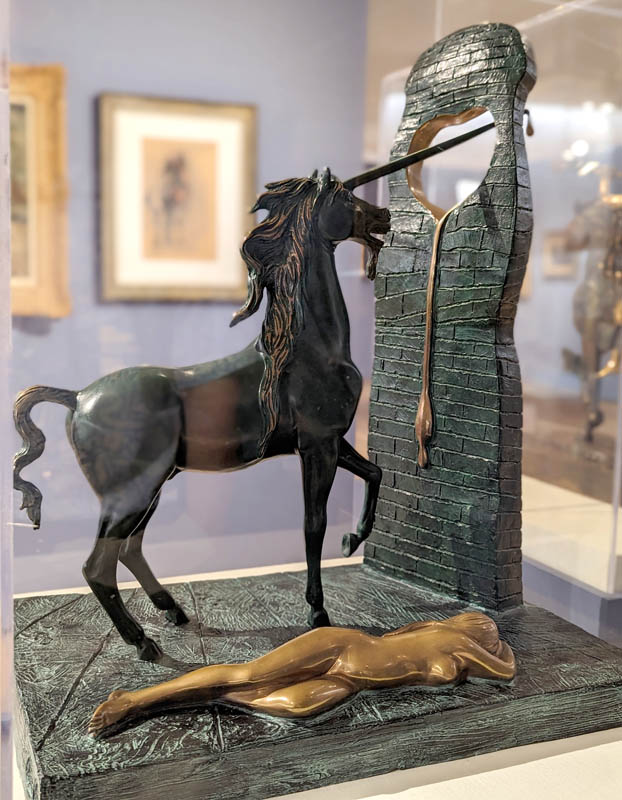
Fear of his father
In his surrealism paintings, Salvador Dali often explores the authoritarian rule of his father, depicting his father faceless and indifferent. He reveals his intense relationship with his short-tempered father in many surreal paintings. For example, he paints small, father-and-son figures in art representing his former closeness with the parent. These small and distant figures give a feeling of warm memories the artist longs for. These surrealist landscapes often have the airless, orange-yellow glow that contrast the dark blue sky sky and the mountains.
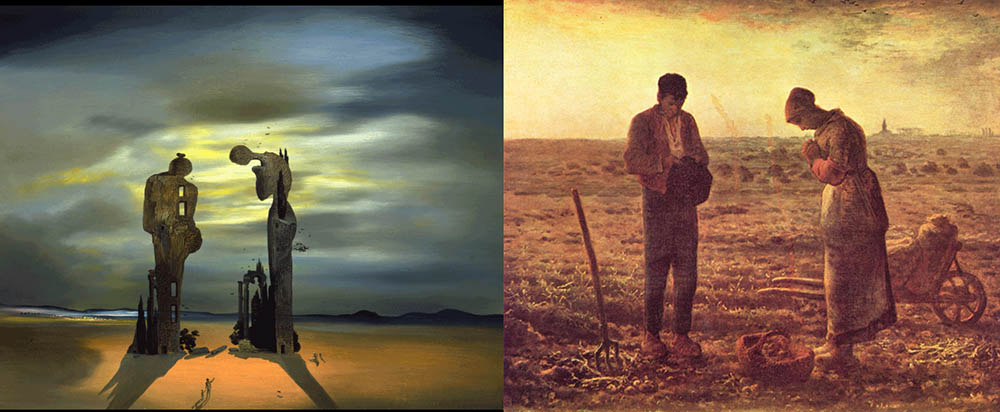
Moreover, Dali shares his family’s tragedy in his surreal paintings. The artist had a brother. Also named Salvador, he died as a toddler less than a year before Dali’s birth. This family tragedy was deeply embedded within his psychic and affected his perception of himself for good.
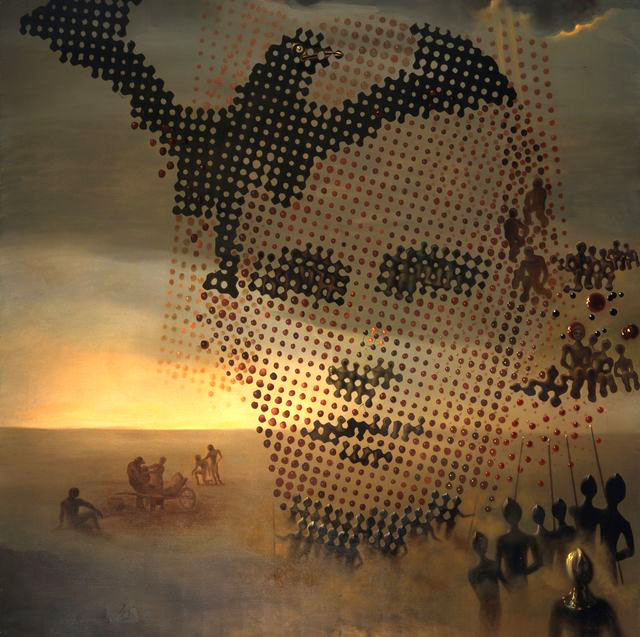
Dali other symbols & meaning
Dali’s art is full of symbols, and some of them are explored in the museum. They include:
Dali crutches meaning: During the surrealist period, Dali paints extremely elongated figures supported by the crutches. The crutches represent his fear of impotence, death. In his paintings, rotting, limping bodies suggest the horrors of wars.
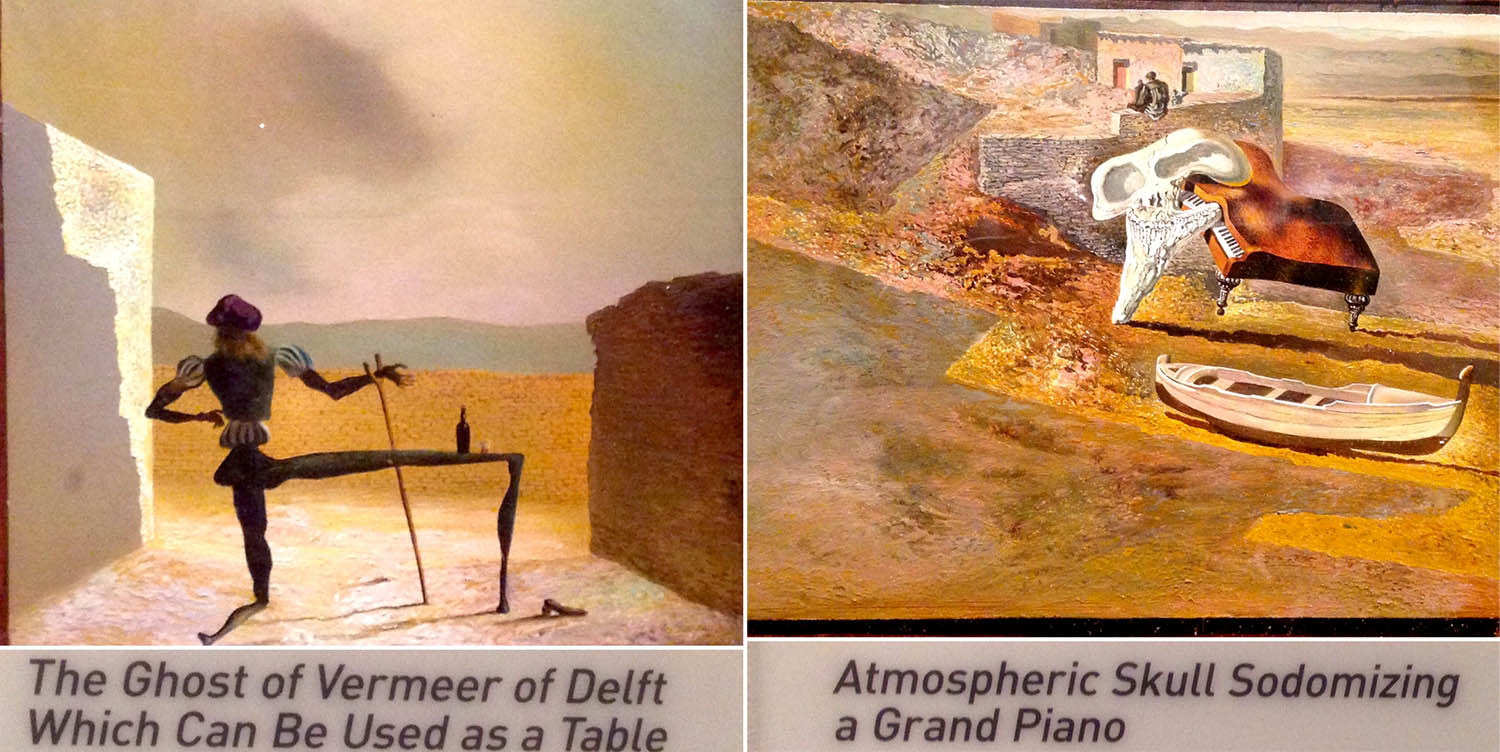
Dali melting clocks and The Persistence of Time meaning: melting clocks represents the fluidity of time. The “Persistence of memory” is influenced by the discovery of the atomic energy and the sub-atomic world. Dali breaks the word into rational sub elements where Time stops limiting us. The image of the melting clock came to the artist after seeing a piece of cheese melting under the sun. Dali saw time as a fluid and relative thing, and his melting clocks represent the passing of time and the relativity of our perception of it.
While I don’t have the image of the Persistence of Memory,1931 located at the Museum of Modern Art in New York, I can show you some variations on the theme I found in other art museums.
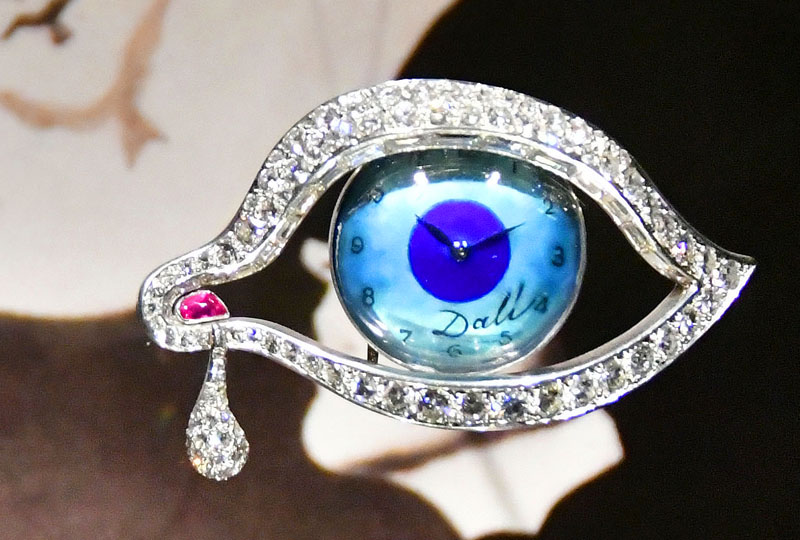
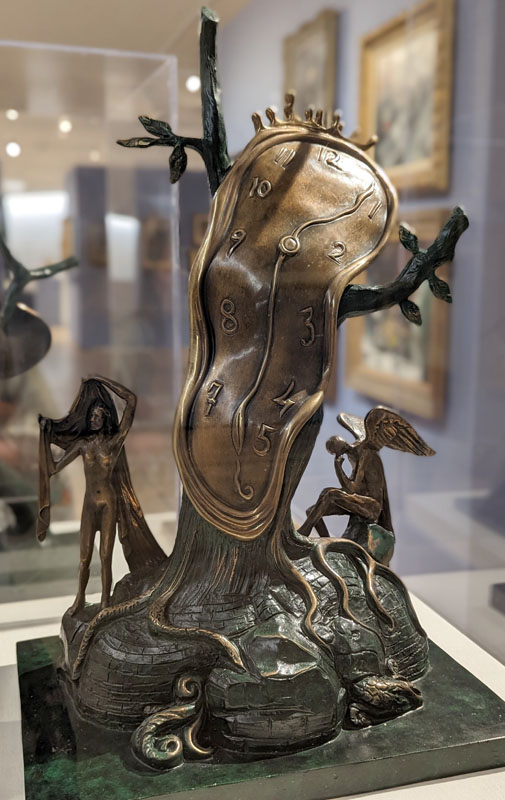
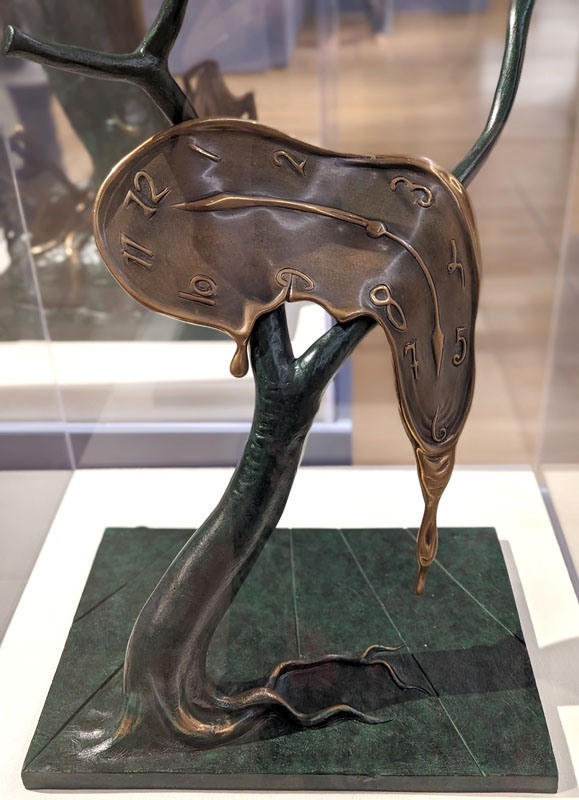
Dali Elephants symbolism: Elephants are often associated with strength and wisdom, but Dali also saw them as symbols of the unconscious mind.
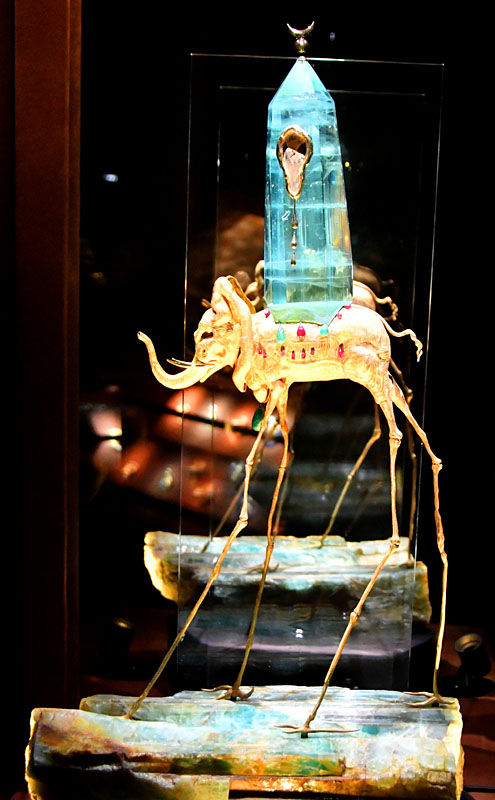
Dali Lobster symbolism: Lobsters are another symbol of the unconscious mind, and they are also associated with sexuality and transformation.
Dali Ants meaning: Ants are often seen as a symbol of industry and cooperation, but Dali also saw them as symbols of death and decay and decomposing prey.
Dali Burning giraffes meaning: Burning giraffes are a symbol of Dali’s own personal fears and insecurities. They are also a symbol of the fragility of life and the inevitability of death.
Dali Piano symbolism: Piano represents a fond memory of summer concerts at the beach, and a scary memory of books his father placed on the piano that had the illustrations of the sexually transmitted diseases.
Dali Roses symbolism: roses represent female beauty and sexuality for the artist.
Dali Venus meaning: Venus represents female love and beauty.
Dali Melting, broken eggs symbolism: these are symbols of memories in the mother’s womb.
Dali Keys meaning: keys represent unlocking the unconscious mind.
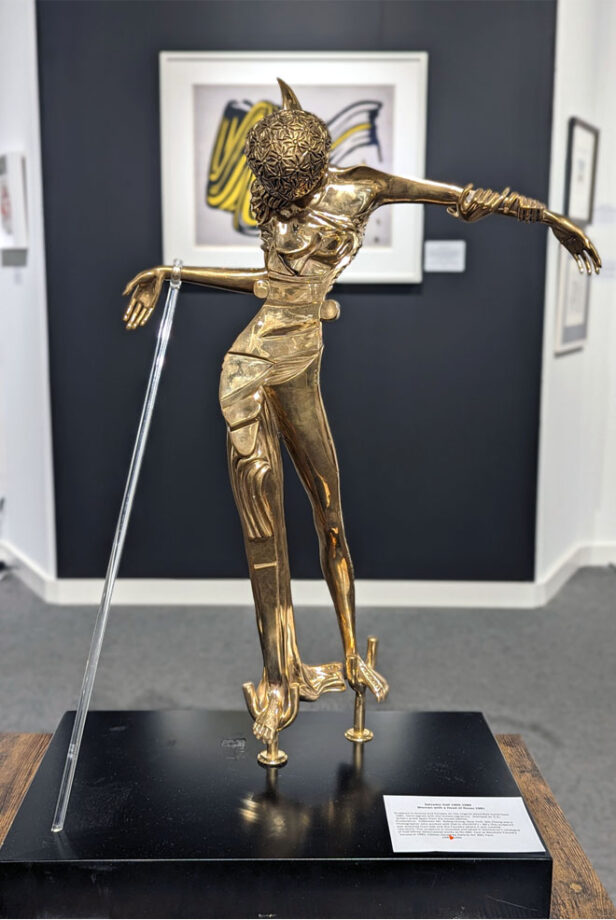
Gala: artist’s muse, wife & promoter
Salvador Dali was a tireless self-promoter. Together with his Russian-born wife and manager – Gala (Elena Ivanovna Diakonova) they worked on connections, marketing, and new job opportunities for the artist. Dali might not have achieved his fame during his lifetime, if he and his wife didn’t pursue those relationships and connections. The couple lived between the U.S. and Europe, while Dali not only painted and exhibited his work in galleries, but also worked on his jewelry, opera sets and costume design. He also contributed to the art scene with his book writing, numerous illustrations, holograms production, and the creation of the dream-like sequences for the Hitchcock’s film Spellbound.
While exploring the art museum, it’s interesting to see how close Dali and Gala were, how she influenced the artist, and how strong their partnership was despite their open marriage arrangement. Considerably older and not a striking beauty, Gala captured Dali’s heart at once when they first met in 1929. She had an affair with Dali and later became his life-long muse. Gala divorced her husband, French poet and one of the founders of the surrealists, Paul Eluard to marry Dali.
We can recognize Gala’s face in many of his paintings where she models for the artist both clothed and nude. Gala becomes a symbol of the female perfection for the artist. In the Dali museum at St. Pete you see Gala in a double painting of “Lincoln” and as virgin Mary in “Columbus.”
Dali dies in 1989 after receiving the international acclaim with his retrospective shows in Germany, Spain, U.S.A, Holland, England, and Japan. Every artist begins his journey in the begging but not every artist reaches the end with fame. As artists, we go through many stages and only the persistent and social ones seem to win. Dali succeeds threefold.
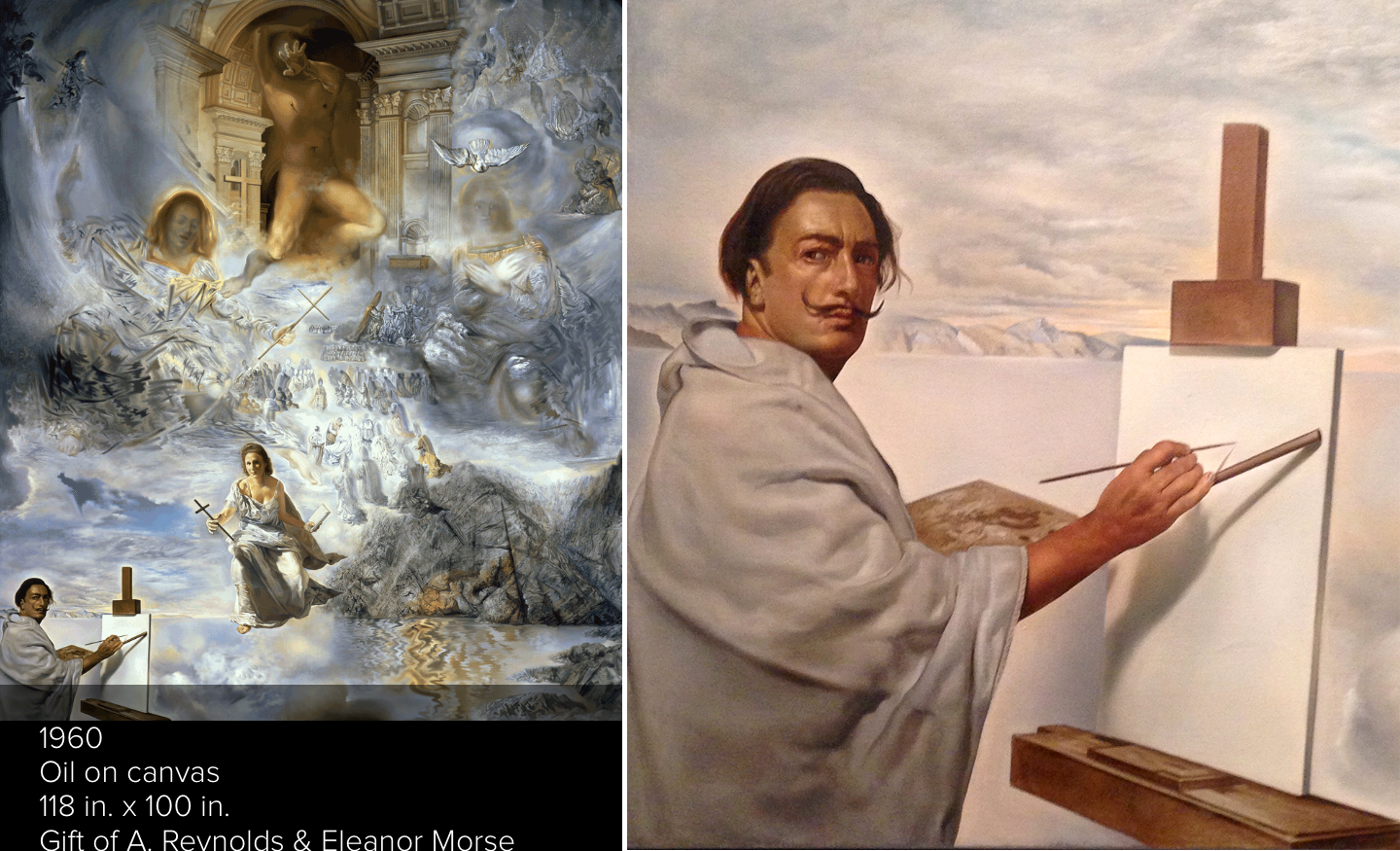
The Dali museum houses a very good, once private art collection of A. Reynolds and Eleanor Morse. They started their Dali collection in 1943. In 1982 the Dali museum in St. Pete was inaugurated. The art collectors ran out of wall space and decided to build this museum and gift their art collection to the public. What’s amazing to see here is how many paintings they acquired from one artist that included both huge canvases and tiny pieces, all of which hung in their house in Cleveland.
I recommend to sign up for the virtual tour of one of the Dali’s paintings on the 3d floor (free with admission). It’s really fun. Also, download the museum’s app that guides you through the collection. Check out their special events schedule and evenings at the museum. Official websites: St.Petersburg http://thedali.org/ and Spain https://www.salvador-dali.org/
To read about the artist’s museum in Spain: https://veronicasart.com/talent-art-dali-theater-museum-in-figueres-spain/